Sporting
Fish Hawks in Paradise
Set two top-notch anglers loose in the untouched waters off Andros Island and you have a master class in angling—and pure joy
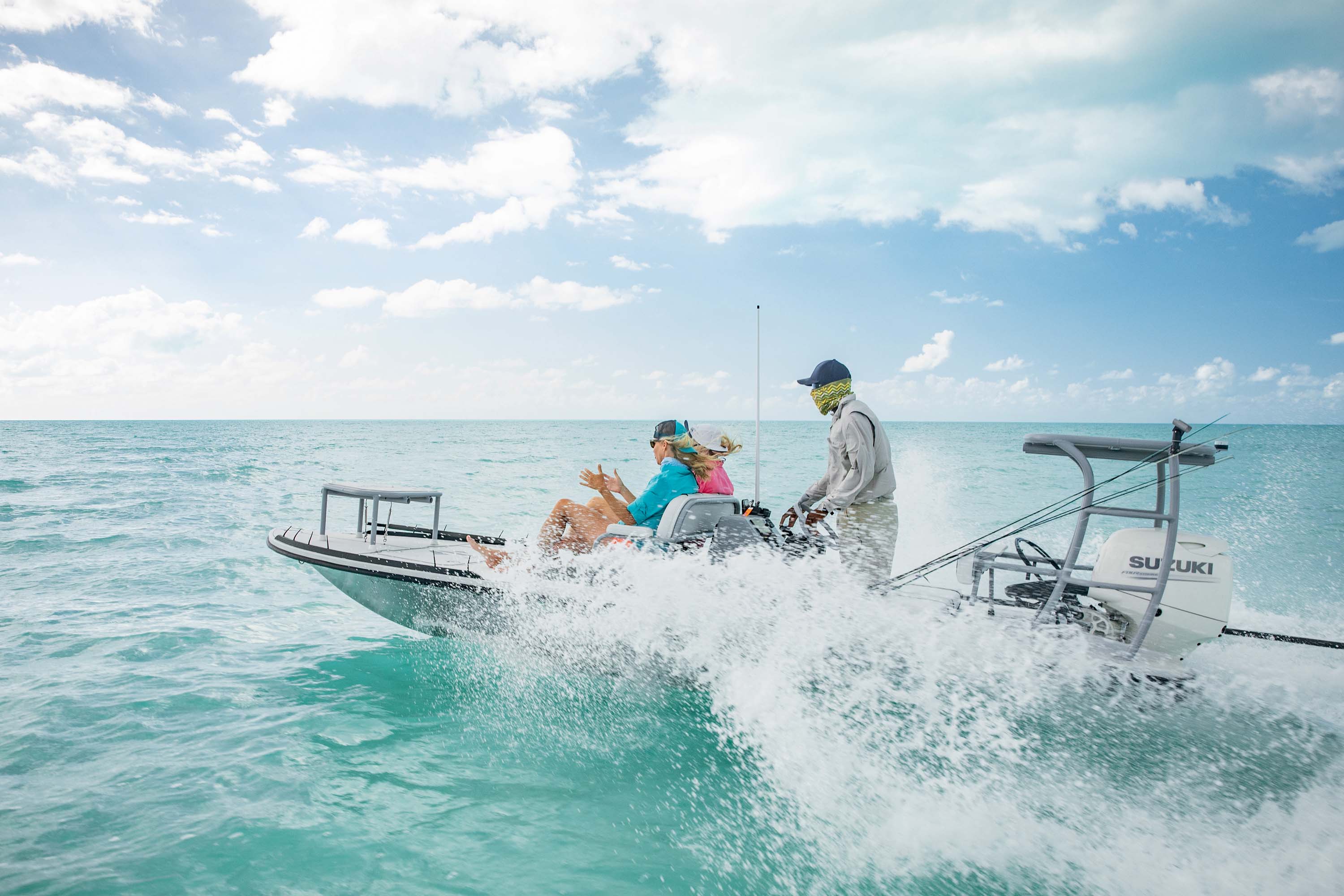
Photo: Eric Kiel
Guide Dencil Moxey runs the skiff to a new flat.
On our first morning of fishing, we leave the mother ship Eleven at a leisurely 8:30 and run north for half an hour to a little shoreline flat. It is a pluperfect bonefish morning: cloudless; the sun just high enough at our backs for good spotting; just enough breeze, also at our backs, to riffle the water. John Green, our guide, shuts down the engine well off the flat and poles in to it against an outgoing tide.
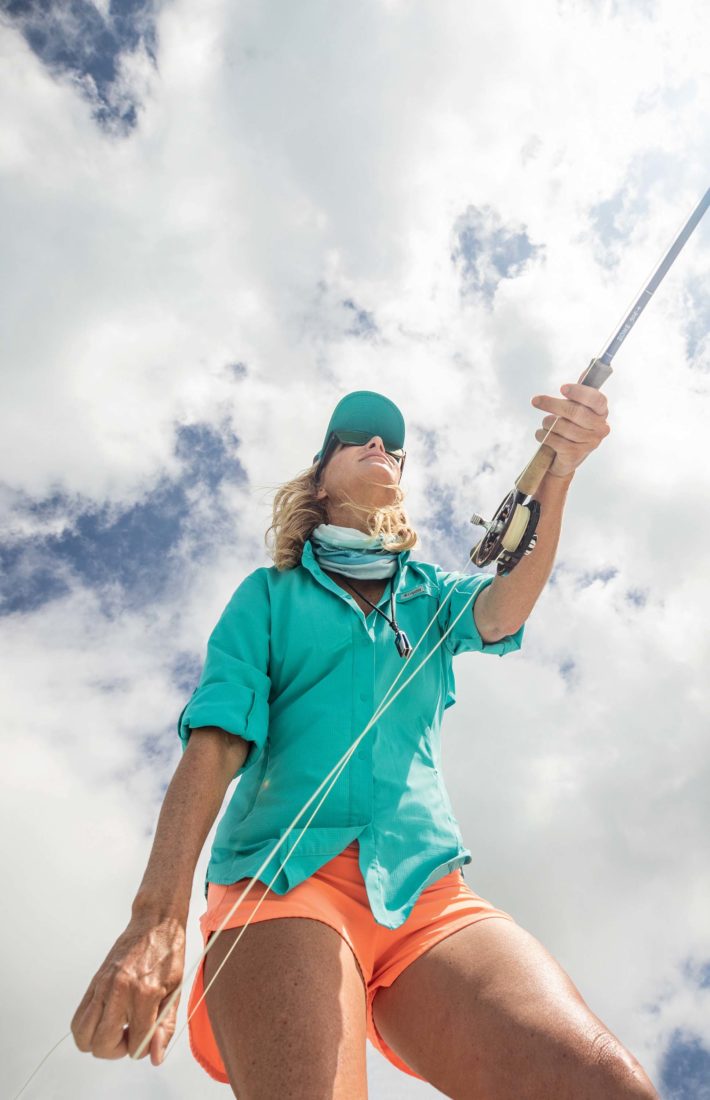
Photo: Eric Kiel
Meredith McCord targets a bonefish.
And there, thirty feet from the shoreline and no more than six feet off the bow, is a bonefish—lying perfectly still in the water and facing the skiff. As if waiting for us! As if it held a little sign saying, “Catch me!”
Green hands Meredith her rod, and she stands up and does just that—with a perfect backhand wrist flick of a cast that drops the fly one foot in front of the bonefish’s nose.
“Your turn,” she says to me when the fish is released.
“No thanks,” I say. I open my first Kalik of the day, stretch out on the console seat, and add, truthfully, “I’m happy watching you fish.”
Meredith smiles. “That,” she says, stepping up onto the bow, “is just what my father used to say.”
I love fishing with fish hawks—people who never have a blasé day on the water, who fish as if their next meal depends on it, with intensity, skill, and brio, a combination that in my experience tends to make fish want to open their mouths.
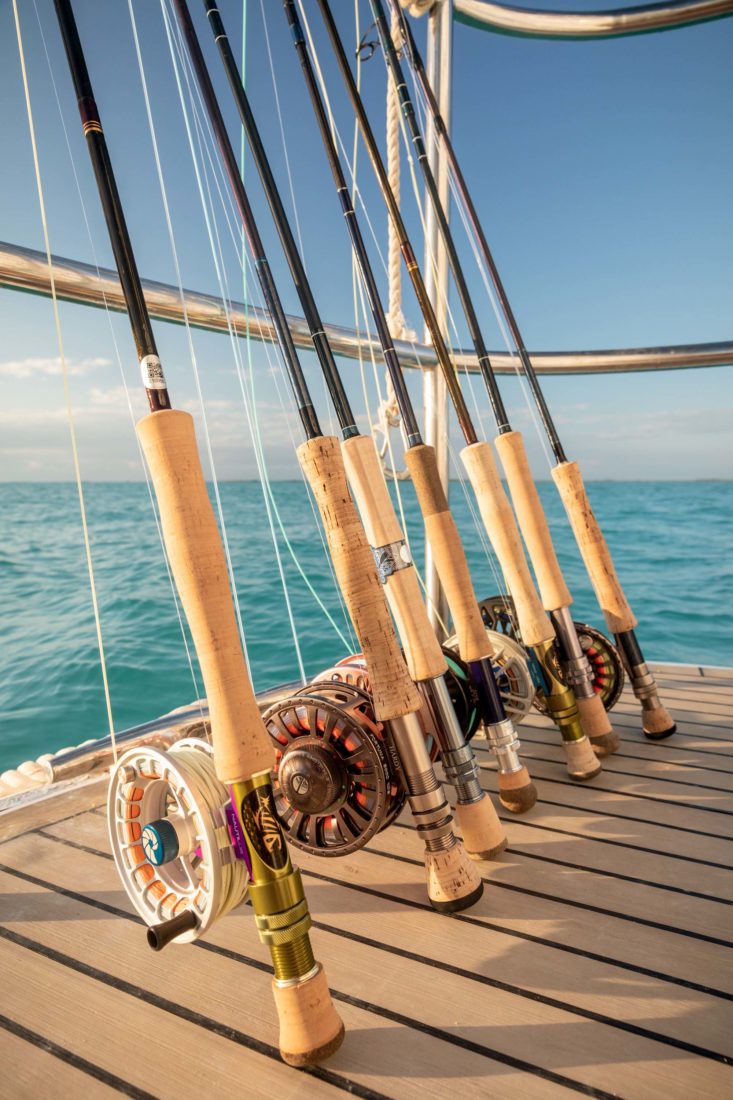
Photo: Eric Kiel
Fly rods at the ready.
And I particularly love fishing with female fish hawks, whose oblique approach to the sport paints it for me, when I am in their company, in fresh, revivifying colors. So when I had the opportunity last February to fish with two such women off a mother ship in the Bahamas, I crashed it like a trout on caddis and invited my friend Richard French to join us.
One of these women was my daughter, Greta Gaines, my favorite fishing partner since she was old enough to hold a rod—at about age six, a spinning rod for bass in Alabama, and then a fly rod by the time she was eight for brook trout and smallmouths in New Hampshire. Since then, she and I have angled for dozens of species in dozens of places, and Greta brings to her fishing the same raptor qualities she brings to everything else she does. A “life hawk,” you might call my daughter and not be wrong: the first female World Extreme Snowboard champion and cofounder of the first all-women snowboarding camp; host for three years of an adventure-travel series on the Oxygen channel; competitor in the first Pro Women’s Bass Tour for ESPN; a successful singer-songwriter out of Nashville; founder and CEO of two beauty-product companies; a mother and wife; and a onetime holder of the female fly-rod world record for striped bass on two-pound-test tippet.
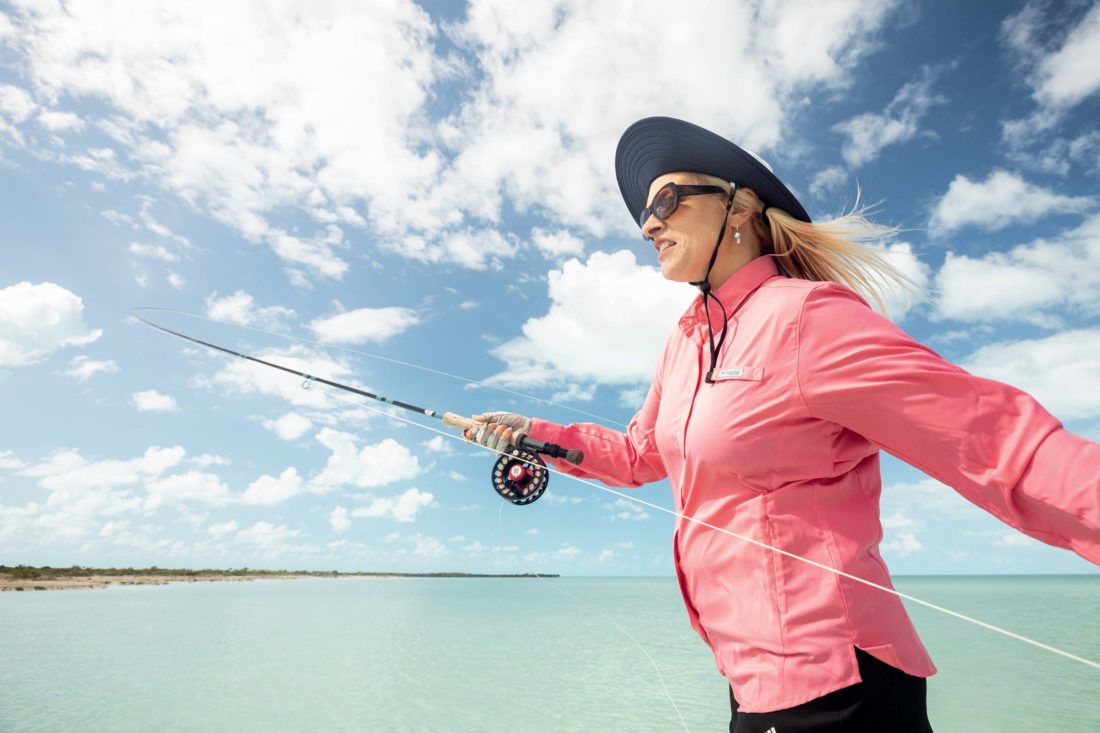
Photo: Eric Kiel
Greta Gaines in pursuit of bonefish.
The second woman was Meredith McCord, who has also swooped on her eclectic life like a falcon and has held a fishing world record or two herself.
By 10:00 a.m. I am well into my second Kalik, and McCord has caught eight bonefish and had two more come off the hook. As Green poles up the shoreline, McCord stands on the bow, firing off pinpoint-accurate forehand and backhand casts, hooking almost every fish she throws to, and all the while talking to me over her shoulder in answer to a question I had asked her two hours earlier.
The question was this: “So how did you get into fishing for world records?”
Her father—Rick McCord, a successful commercial real estate developer from Houston—started her fishing forty-two years ago when she was three, sitting in her mother’s lap with a pole on a Texas bass pond he owned, and later in Canada on Lake of the Woods, where they had a summer cabin. All of her family fished and hunted, and for McCord and her younger brother and sister, there was no greater pleasure while growing up than following their dad around with a rod or a gun.
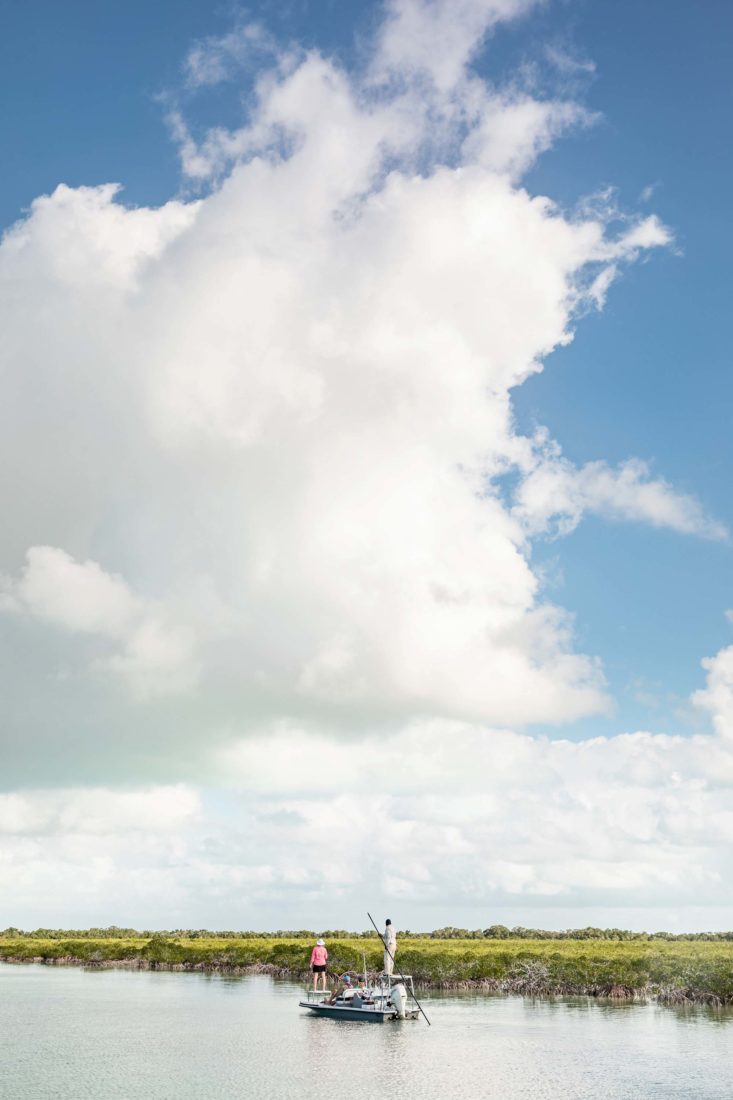
Photo: Eric Kiel
Working a mangrove shoreline.
After seeing A River Runs through It when she was in college at Vanderbilt, she took up fly fishing, and spent the summer after she graduated waiting tables in Jackson Hole, Wyoming, and learning how to do it right. Following a fling with commercial real estate, scotched by having to wear pantyhose, she moved back to Houston, started from scratch a paint-your-own pottery studio, and turned it into a cash-cow business with five outlets called the Mad Potter.
Whenever she was not working or doing mission work with orphans in Russia and Africa, she was fishing with her dad—in Belize, Canada, Alaska, Venezuela, Christmas Island, and the Seychelles. In 2012, in Venice, Louisiana, she set her first women’s world record with a 32½-pound redfish caught on 16-pound tippet. Her father was thrilled over the record. He encouraged her to go for others, and on their next trip to the Seychelles, she obliged him with two more.
In 2013 Tailwaters Fly Fishing Company hired her to host trips and to scout angling locations and lodges. She spent much of that year on the water, and by the time she and her dad returned to the Seychelles in 2014, she had pushed her number of world records to over thirty.
On that trip, McCord and her father caught seventeen giant trevallies between them. It was their best trip ever, and it was Rick’s last. Shortly after they returned home, he was diagnosed with stage-four kidney cancer. He told Meredith that from then on, she would have to fish for him, that he wanted her to keep chasing records, and to think of him being with her to witness every one. She told him he would live to see her set a hundred, and he almost did. When he died, in October 2015, she had seventy-eight. She caught the hundredth on Father’s Day the next year—a largemouth bass, from the Texas pond her dad had built and stocked, and in which he had taught her to fish.
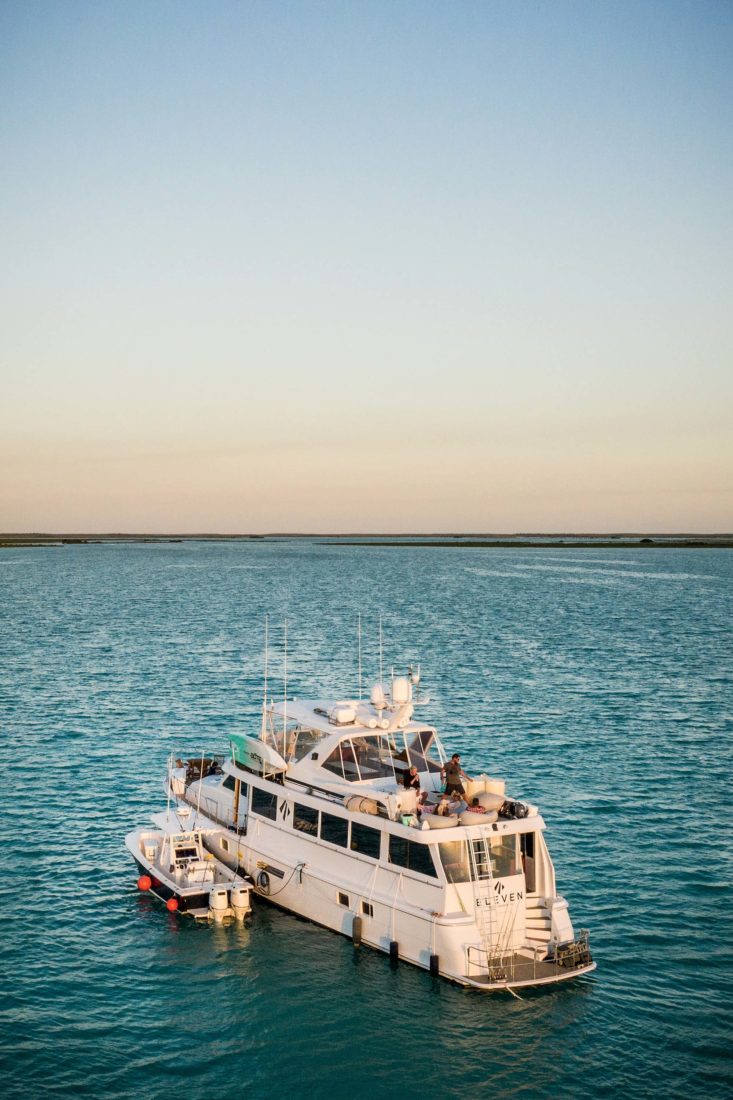
Photo: Eric Kiel
The mother ship Eleven at anchor.
Since then, McCord says, she has been setting records for him. As of our trip, she has 158 of them and 12 pending—about 50 of those on spinning tackle, the rest on fly rod.
“How many is enough?” I ask her. We are having lunch now—after a more or less twenty-bonefish morning for McCord that could have served as a master class in flats fishing—tied up boat to boat with photographer Eric Kiel and his guide.
She says, “The top female record holder in the world has around two hundred, and she is pretty much retired. So over two hundred, for sure. After that, I don’t know. It’s a game, and it’s fun. As long as I’m having fun, I’ll keep on playing it.”
The way things have been breaking for her recently, that might be quite a while. Largely because of the reputation her records have earned her, the woman is having way more than a little fun. She leaves in five days to fish in Dubai and then to host a group of anglers in the Seychelles. Last year alone she fished in Belize, Canada, Argentina, Iceland, the Bahamas, Russia, Mongolia, and Bolivia—eight of the twenty countries in which she has wet lines over the past seven years. She was named the International Game Fish Association Top Female Angler of the Year in 2015 and 2016; won the prestigious Ladies Tarpon Fly Tournament in Islamorada, Florida, in 2017; and starred with Tom Brokaw, Huey Lewis, Yvon Chouinard, and others on the TV show Buccaneers and Bones. Her records come from eight countries, and she has them in over forty species of fish—from Atlantic salmon to catfish, dorado to carp. To do that you have to fish a lot, and she does so about 200 days a year, only 15 percent or fewer of those for records, the rest for her own pure joy in it. To fish that much you have to flat love it—records or no records.
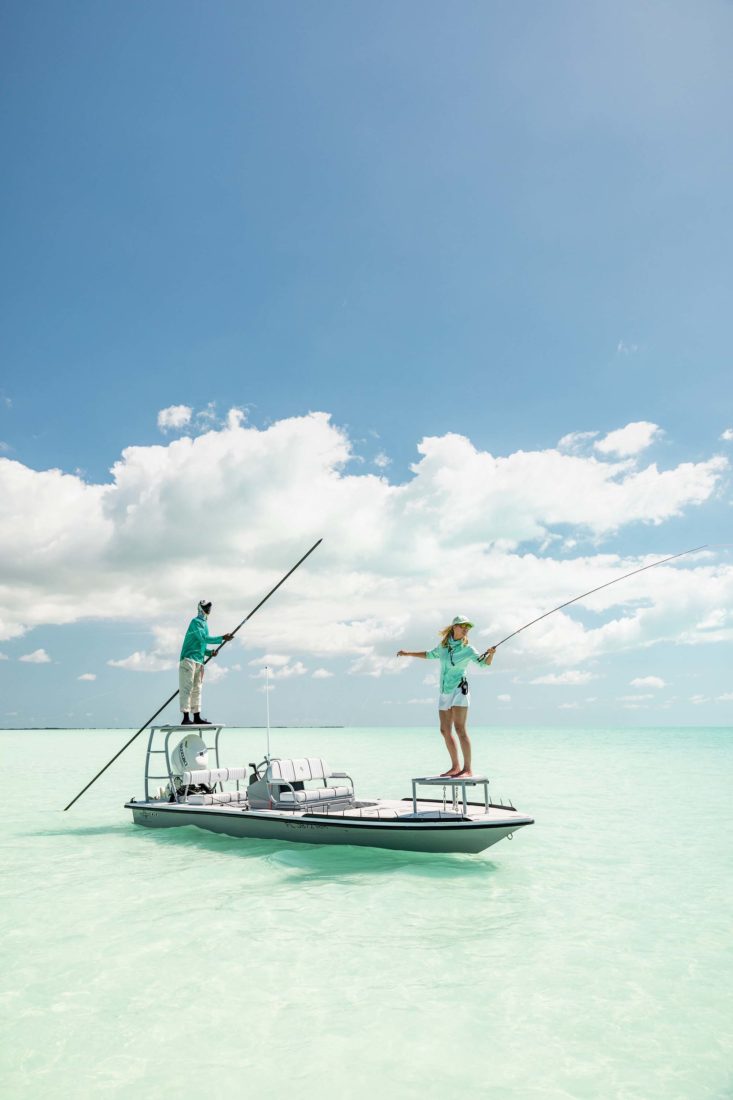
Photo: Eric Kiel
Guide John Green mans the poling platform while McCord makes a backcast.
After lunch Kiel asks McCord to step out of the skiff and wade so he can photograph her casting. As she does that, a barracuda of about twenty pounds idles up to within ten feet of her and stops—pleading, it would seem, like the first bonefish of the morning, for her to catch it. She runs to the boat for her cuda rod and runs back, the fish just waiting for her. She casts, strips. The cuda slashes at the red-and-white popper, misses it, slashes again, and takes the fly a rod’s length away from McCord’s bare legs. It wheels to the right, runs off forty feet of line in an eyeblink, jumps two feet out of the water, its entire body a silver paroxysm of shakes…and spits the hook.
McCord whips around to face us, beaming, hands held wide at her sides, palms up, demanding, “Is this fun, or what?”
The Eleven, which is owned by the luxury travel company Eleven Experience, is based from October through May on the southwest shore of Andros Island, miles from the nearest road or town, in the middle of a 1.3-million-acre national park. Aside from two lodges some forty miles to the north, it is the only accommodation on the west side of Andros, the largest island in the Bahamas, which means that it has the vast amount of flats fishing there virtually to itself. And that fishing—for bonefish, many of them outsize, tarpon and permit in season, barracuda, mutton snapper, and sharks—is about as good as it gets. Within the roughly thirty-five miles that compose the Eleven’s fishery—from the Middle Bight of Andros to the north to the Water Cays at its southern end—there are thousands of isolated flats, as well as a latticework of fish-holding channels, creeks, and lagoons so enormous and complex it would take decades to explore them all.
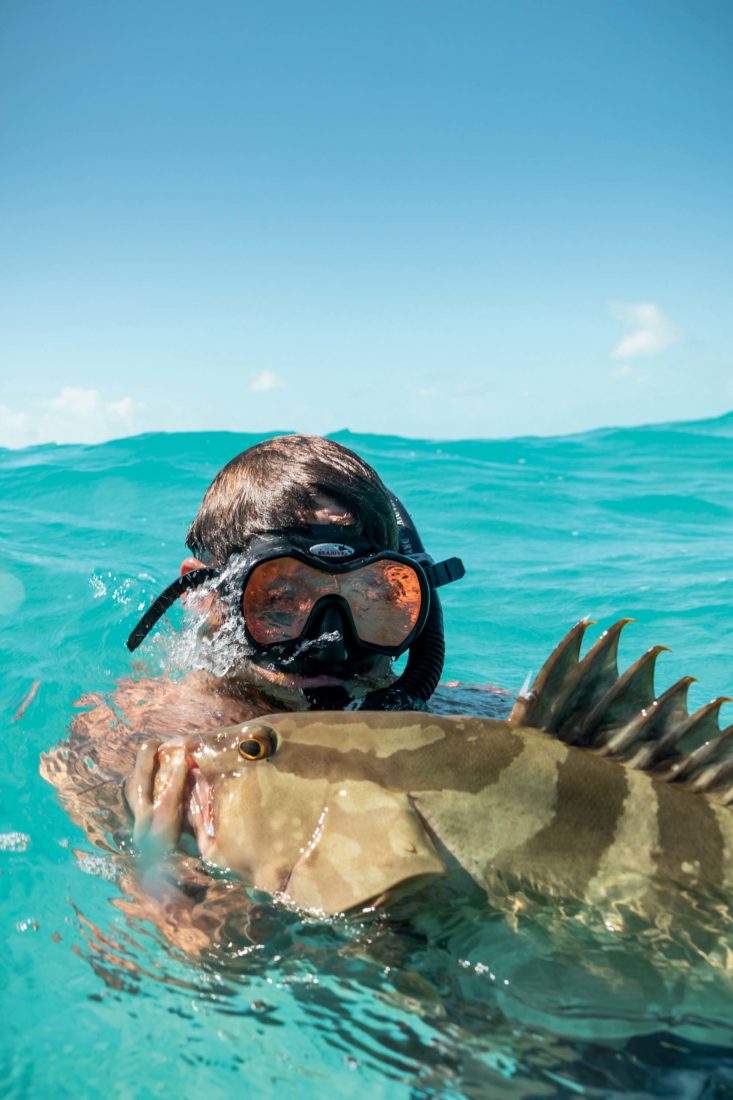
Photo: Eric Kiel
Captain Tom McLaughlin with a grouper.
Being waterborne amid all this piscatory wealth tends to induce a relaxed approach to exploiting it, and one of the advantages the Eleven has over land-based lodges is that you are free to set your own schedule: to go out fishing whenever you want and come back in at your pleasure; to eat a box lunch on the water or return to the ship for one of the chef’s inventive repasts. While you are out, you are fishing from state-of-the-art sixteen-foot Beavertail skiffs, with a team of guides as expert as any in the Bahamas. And what you return to at the end of the day is every bit as high quality as the fishing—a seventy-four-foot Hatteras with three air-conditioned staterooms (for a maximum of six anglers), a spacious and comfortable main salon with satellite TV and a well-stocked library, and an upper deck for cocktails, dinner, and spectacular sunset watching.
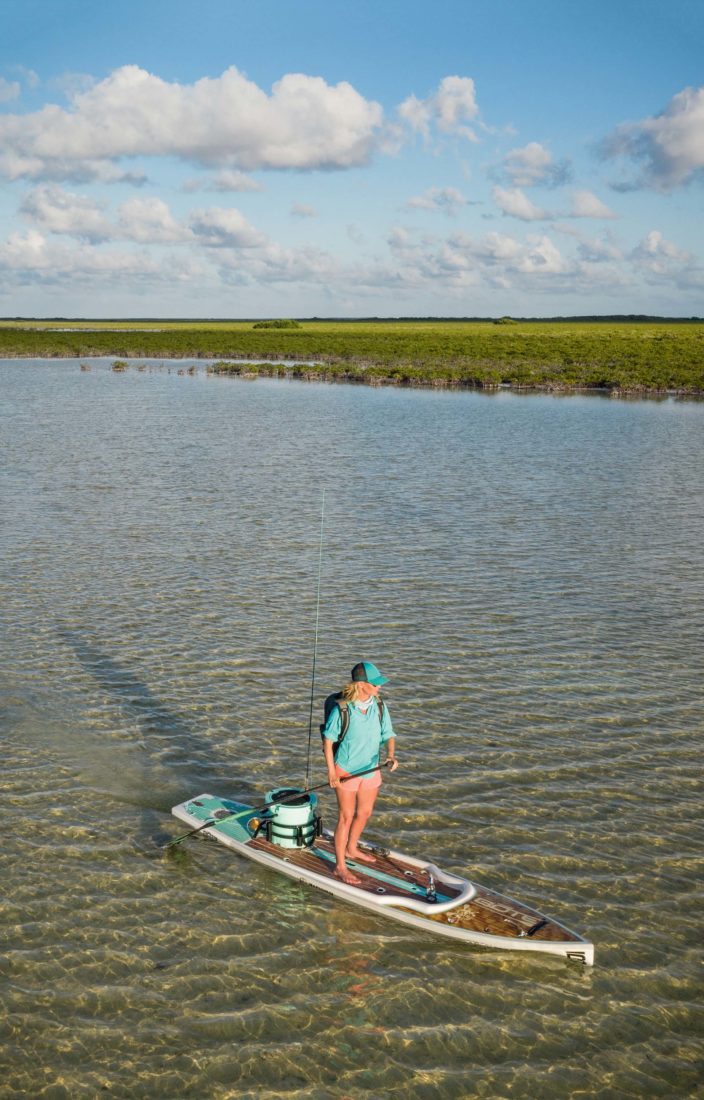
Photo: Eric Kiel
McCord on a paddleboard.
There are countless moving parts to an operation as remote and elaborate as the Eleven. Keeping all of them meshing smoothly, making the extremely difficult look easy almost to the point of nonchalance, is the ship’s captain, Tom McLaughlin, a thirty-seven-year-old ex–tarpon guide and commercial fisherman from Boca Grande, Florida, who ought to wear a ball cap with the words “Captain Competent” printed on it. Working with McLaughlin on the ship are the talented young chef Ethan Greer and an ebullient pint-size mate named Ryan Martin, known as Martini, one of whose agreeable talents is popping up, genie-like, with exactly what you want exactly when you want it.
Which happens this afternoon to be a tray of spicy margaritas presented to McCord and me the moment we step off the skiff onto the mother ship’s fantail, followed by a tray of Greer’s hors d’oeuvres. An hour later we are on the upper deck with Greta, Richard French, and Kiel, refreshed margaritas in hand, watching the sun expire operatically over Great Bahama Bank and hearing about the thirty or so bonefish Greta hooked while fishing with French in the Water Cays.

Photo: Eric Kiel
Selecting flies.
After a fine dinner of sautéed snapper, Greta sings some songs with the ship’s guitar, and we plan the rest of our sybaritic stay on the Eleven. One of the defining characteristics of such a stay is the remarkable vari-
ety of ways you can occupy yourself with rod in hand. There is fishing from the skiffs everywhere, and in the Water and Curley Cut Cays there is boundless white-sand wade fishing. At night, if you are still up to it, there is fishing for rolling tarpon in Miller Creek, and for snapper and jacks off the stern of the ship. There is offshore reef fishing, and there is bonefishing in shallow, landlocked lagoons from stand-up paddleboards. Being dedicated fish hawks, Greta and McCord want to try it all, and over the next two days they give it a hell of a shot—with French and me doing our best just to keep up.
Mccord ties her rods together with pink ribbons. Greta
wrote a song that she sings seductively to bonefish whenever they are not cooperating. McCord assigns voices to various fish—a Spanish accent for jacks, for black drum the voice of Eeyore from Winnie the Pooh. And she does a little shimmy on the bow to illustrate how excited tarpon respond to the palolo worm hatch in the Florida Keys.
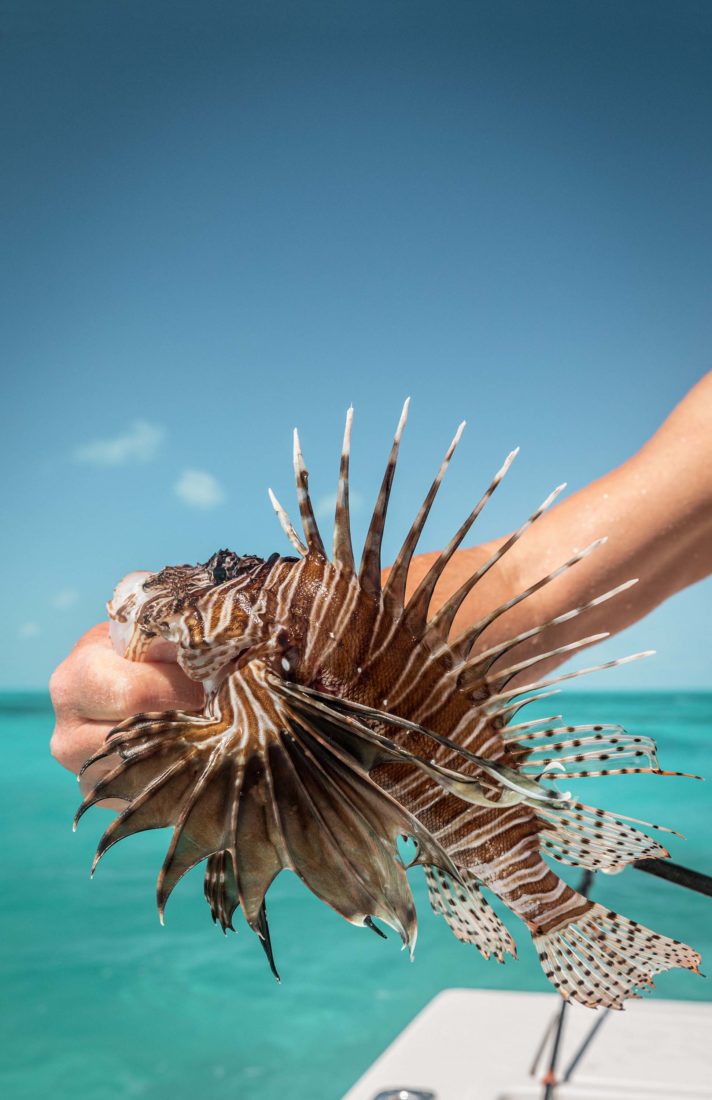
Photo: Eric Kiel
A lionfish.
On this second morning, the three of us are fishing with guide Dencil Moxey in Little Miller’s Creek, and judging by the grin he sports all day, Moxey is as delighted with the fugue of fish-hawk femininity in the boat with us as I am. There is more wind and less sun today. The fishing is slower than yesterday but steady, and, taking turns, the women hook practically every fish they see, while singing together, high-fiving, and talking nonstop between shots about ayurvedic therapy, skin products, the Me Too movement…
“My dad loves this,” says Greta, accurately, when I burst out laughing at one of their exchanges. “It gives him a break from all the guy fishing talk, like ‘So how’s your portfolio, Bob?’ and ‘Could you believe LeBron last night?’”
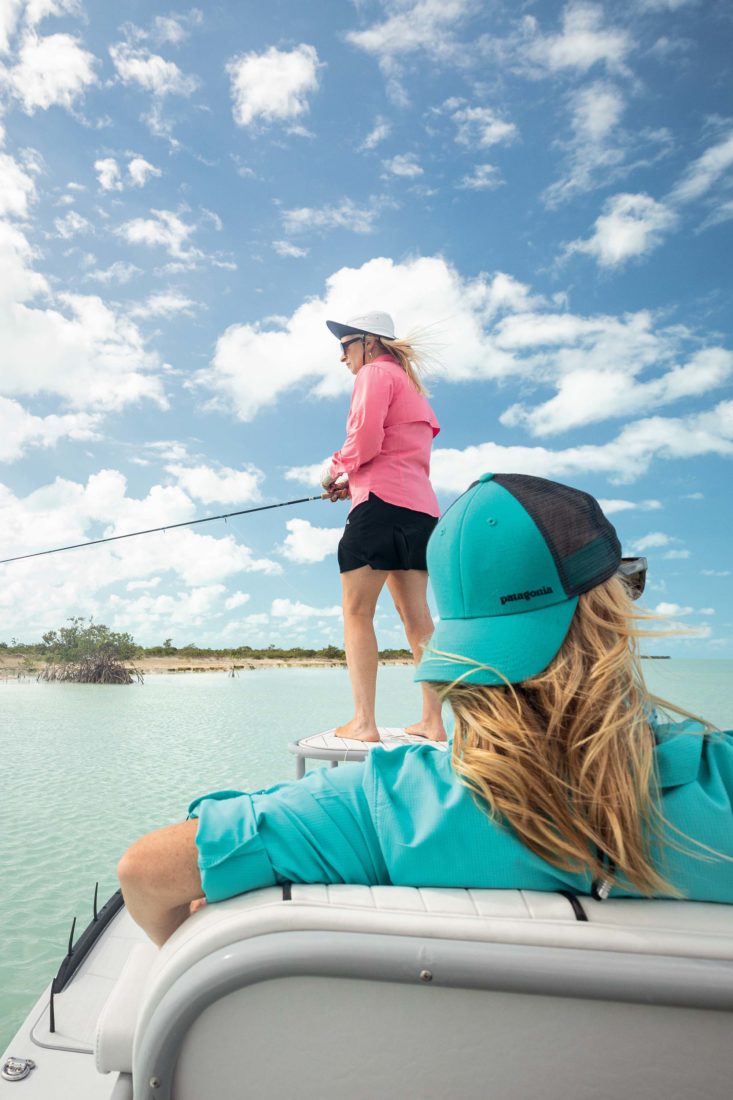
Photo: Eric Kiel
Gaines on the bow.
At 4:30, after a full day in the skiff, the three of us with French, Tom McLaughlin, and Kiel boat out ten minutes from the ship, and walk another five minutes across sun-hardened marl studded with mangrove shoots to a system of small lagoons and creeks, landlocked on three sides with a narrow opening to the ocean seven miles away. There the women and McLaughlin fish from paddleboards in water four to ten inches deep for the thousands of two- to four-pound bonefish that inhabit that system (and many others like it). McCord and McLaughlin don’t return to the ship until after dark. Fifteen minutes later, McCord is on the upper deck mixing up a batch of Fruity Fosters.
The next morning, while French goes bonefishing, McLaughlin fires up the twenty-six-foot Regulator tied to the ship, and he and Martini run the rest of us eight miles offshore to a coral reef lying in nine feet of water. After anchoring the boat, McLaughlin and Martini throw out a chum of live anchovies netted earlier that day. Within minutes, mutton and mangrove snapper, grouper, jacks, needlefish, and a big barracuda appear behind the stern, and Greta and McCord catch them on streamers and poppers—Greta whooping, as her grandfather used to do, on every hookup.
The weather is flawless. Reggae plays at high volume over the Regulator’s sound system. We crack Kaliks, soak up the sun and catch fish, and later snorkel over the coral heads among clouds of snapper, jacks, and needlefish. McLaughlin spears a big Nassau grouper and Martini a lionfish for dinner. While Greta sings to herself and hauls in jacks and snapper off the stern, McCord—treading water with her mask on her forehead—watches Martini deposit his lionfish in the live well, then asks him for a spear. Ten minutes later she is holding up her own lionfish at the end of the spear and shouting to Martini, “Mine is bigger!”

Photo: Eric Kiel
Dusk settles in.
That night Greer makes sashimi out of the lionfish and steams the grouper, serving it with crushed cashews and hoisin sauce, alongside brussels sprout kimchi, tempura-fried pickles, and four different sushis made of grouper, shrimp, lionfish, and green apples with white-truffle oil.
After dinner Greta sings some tunes. Halfway through her killer cover of “Angel from Montgomery,” I look over at McCord and see tears running down her cheeks, which she makes no effort to hide or wipe away. Later I ask her why she was crying.
“I was watching you watching Greta while she sang,” she says. “Seeing how proud you are of your daughter.”
About the Bahamas
This article was written before Hurricane Dorian devastated the northern Bahamas in early September. Andros Island, where the feature is set, was largely unaffected by Dorian and is open for visitors. The economy of the Bahamas depends on tourism, and the country’s ministry of tourism “urges consumers to know that the best thing they can do for the country, now more than ever, is simple: visit The Bahamas.” Get more information about visiting, and find out how you can help the recovery efforts in Grand Bahama and the Abacos.







